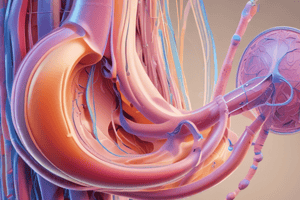Podcast
Questions and Answers
What is the primary advantage of using an indwelling catheter for urine output monitoring?
What is the primary advantage of using an indwelling catheter for urine output monitoring?
- It requires no patient consent.
- It is the least invasive method.
- It provides real-time data on urine output. (correct)
- It allows for periodic manual collection.
Which technique is best suited for estimating bladder volume non-invasively?
Which technique is best suited for estimating bladder volume non-invasively?
- Urine Dipsticks
- Direct Measurement
- Bladder Scanner (correct)
- Timed Urine Collection
What unit is standard for documenting urine output in medical records?
What unit is standard for documenting urine output in medical records?
- Ounces
- Liters
- Cubic centimeters
- Milliliters (correct)
Which of the following is NOT a component of clinical significance related to urine output monitoring?
Which of the following is NOT a component of clinical significance related to urine output monitoring?
Why is it important to document anomalies such as oliguria or anuria?
Why is it important to document anomalies such as oliguria or anuria?
What is the role of urine dipsticks in urine output monitoring?
What is the role of urine dipsticks in urine output monitoring?
During which phase of patient care is urine output monitoring most critical?
During which phase of patient care is urine output monitoring most critical?
What does fluid balance assessment help evaluate?
What does fluid balance assessment help evaluate?
What documentation aspect enhances the effectiveness of urine output monitoring?
What documentation aspect enhances the effectiveness of urine output monitoring?
Which of the following could indicate a patient at high risk for complications based on urine output patterns?
Which of the following could indicate a patient at high risk for complications based on urine output patterns?
Study Notes
Urine Output Monitoring Study Notes
Measuring Techniques
-
Direct Measurement:
- Collected in a graduated container.
- Ideal for accurate volume assessment.
-
Indwelling Catheter:
- Continuous monitoring via a catheter.
- Provides real-time data on urine output.
-
Bladder Scanner:
- Non-invasive method to assess bladder volume.
- Useful in estimating post-void residual volume.
-
Timed Urine Collection:
- Collection over a specified period (e.g., 24 hours).
- Assesses total urine output for evaluation.
-
Urine Dipsticks:
- Assists in assessing urine composition.
- Provides additional information alongside volume.
Documentation Standards
-
Frequency of Monitoring:
- Document urine output at regular intervals (e.g., hourly or every shift).
-
Units of Measurement:
- Record output in milliliters (mL) for consistency.
-
Clinical Context:
- Include patient condition, medications, and any relevant interventions.
-
Anomalies:
- Note any abnormalities (e.g., oliguria, anuria) along with the time and circumstances.
-
Electronic Health Records:
- Utilize EHR systems for accurate and efficient documentation.
- Ensure data is easily accessible for healthcare team members.
Clinical Significance
-
Fluid Balance Assessment:
- Helps evaluate hydration status and fluid retention or deficit.
-
Renal Function Monitoring:
- Changes in urine output can indicate acute kidney injury or renal impairment.
-
Medication Effects:
- Important for monitoring the effects of diuretics or other medications on kidney function.
-
Postoperative Care:
- Essential for assessing recovery from anesthesia and surgery.
-
Patient Outcomes:
- Correlates with overall patient health; low output may necessitate further investigation or intervention.
-
Risk Stratification:
- Urine output patterns can help in identifying high-risk patients for complications.
Measuring Techniques
- Direct Measurement:
- Urine collected in a graduated container for accurate volume assessment.
- Indwelling Catheter:
- Enables continuous urine output monitoring, providing real-time data.
- Bladder Scanner:
- A non-invasive tool used to estimate bladder volume, useful for assessing post-void residual.
- Timed Urine Collection:
- Involves collecting urine over a set timeframe, such as 24 hours, to evaluate total output.
- Urine Dipsticks:
- Useful for analyzing urine composition, providing critical information in conjunction with volume measurements.
Documentation Standards
- Frequency of Monitoring:
- Urine output should be documented regularly, commonly every hour or per shift.
- Units of Measurement:
- Output should consistently be recorded in milliliters (mL) for clarity and precision.
- Clinical Context:
- Document patient conditions, medications, and any relevant interventions affecting output.
- Anomalies:
- Record any abnormalities, such as oliguria or anuria, specifying the time and context of occurrence.
- Electronic Health Records:
- Utilize EHR systems for precise documentation, ensuring accessibility for healthcare providers.
Clinical Significance
- Fluid Balance Assessment:
- Aids in evaluating patient's hydration status and identifying fluid retention or deficit.
- Renal Function Monitoring:
- Changes in urine output can signal acute kidney injury or renal impairment.
- Medication Effects:
- Critical for assessing the impact of diuretics and other medications on renal function.
- Postoperative Care:
- Essential for monitoring recovery post-anesthesia and surgery, ensuring patient safety.
- Patient Outcomes:
- Low urine output may indicate worsening health and necessitate further investigation or intervention.
- Risk Stratification:
- Patterns in urine output can aid in identifying patients at higher risk for complications.
Studying That Suits You
Use AI to generate personalized quizzes and flashcards to suit your learning preferences.
Description
Explore the various techniques for monitoring urine output effectively. This quiz covers direct measurement, catheterization, bladder scanning, and time-specific collection methods, each critical for accurate assessments in clinical settings. Enhance your understanding of these procedures to improve patient care.




